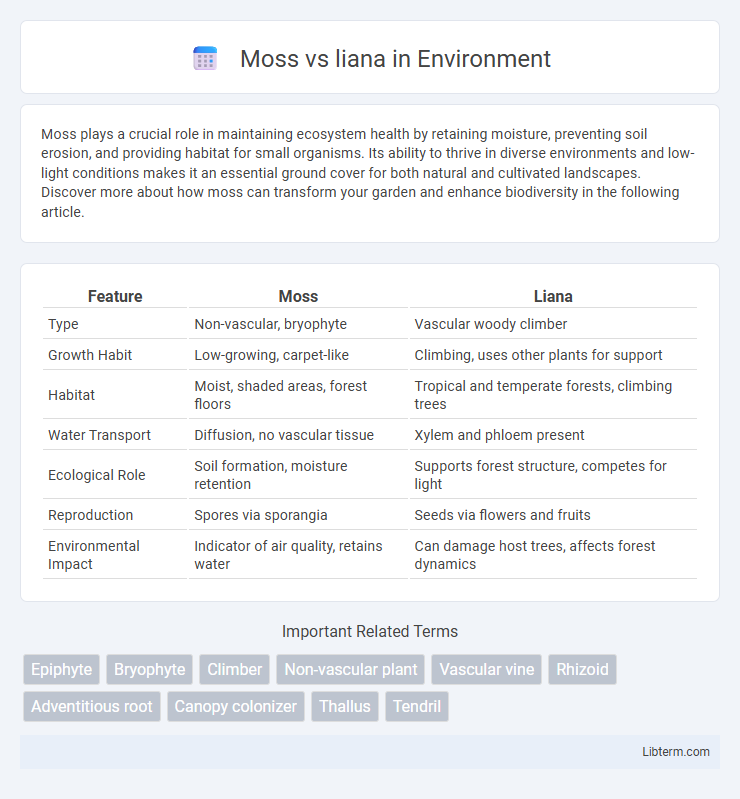Moss plays a crucial role in maintaining ecosystem health by retaining moisture, preventing soil erosion, and providing habitat for small organisms. Its ability to thrive in diverse environments and low-light conditions makes it an essential ground cover for both natural and cultivated landscapes. Discover more about how moss can transform your garden and enhance biodiversity in the following article.
Table of Comparison
| Feature | Moss | Liana |
|---|---|---|
| Type | Non-vascular, bryophyte | Vascular woody climber |
| Growth Habit | Low-growing, carpet-like | Climbing, uses other plants for support |
| Habitat | Moist, shaded areas, forest floors | Tropical and temperate forests, climbing trees |
| Water Transport | Diffusion, no vascular tissue | Xylem and phloem present |
| Ecological Role | Soil formation, moisture retention | Supports forest structure, competes for light |
| Reproduction | Spores via sporangia | Seeds via flowers and fruits |
| Environmental Impact | Indicator of air quality, retains water | Can damage host trees, affects forest dynamics |
Introduction to Moss and Liana
Mosses are small, non-vascular plants that thrive in moist, shaded environments, playing a crucial role in soil formation and moisture retention. Lianas are woody climbing plants predominant in tropical forests, using trees for support to reach sunlight and contributing significantly to forest dynamics and biodiversity. Both mosses and lianas are essential components of their ecosystems, but they differ fundamentally in structure, habitat, and ecological functions.
Definition and Characteristics of Moss
Mosses are non-vascular, small, green plants belonging to the Bryophyta division, characterized by their simple leaves and stems without true roots. They reproduce via spores rather than seeds and thrive in moist, shaded environments due to their reliance on water for fertilization. Mosses form dense mats that help retain soil moisture and prevent erosion, distinguishing them ecologically from lianas, which are woody climbing plants.
Definition and Characteristics of Liana
Lianas are woody climbing plants that root in the soil and use trees or other vertical supports to reach sunlight in dense forests. Unlike moss, which are non-vascular and small, lianas have vascular tissues that enable efficient transport of water and nutrients, supporting their large size and long lifespan. They play a crucial role in forest ecology by providing structural connectivity and habitat for various animals.
Habitat and Distribution Differences
Mosses primarily thrive in moist, shaded environments such as forest floors, wetlands, and tundras, exhibiting a cosmopolitan distribution across temperate and tropical regions. Lianas, woody climbing plants, are predominantly found in tropical rainforests where they utilize trees for support to reach sunlight, contributing to forest canopy complexity. While mosses prefer stable, low-light habitats with high humidity, lianas dominate structurally dynamic, sunlit ecosystems with high vertical stratification.
Growth Patterns: Moss vs Liana
Moss exhibits a non-vascular, carpet-like growth pattern, spreading horizontally on surfaces such as soil, rocks, or tree bark, and thrives in moist, shaded environments. In contrast, lianas demonstrate a woody, climbing growth habit, relying on trees or other structures for vertical support to reach sunlight in dense forests. The distinct growth strategies of mosses and lianas reflect their adaptations to light acquisition and habitat stability in diverse ecosystems.
Ecological Roles in Ecosystems
Mosses play a critical role in ecosystems by retaining moisture, preventing soil erosion, and providing habitat for microfauna, while lianas contribute to forest dynamics by connecting tree canopies, enhancing structural complexity, and facilitating nutrient cycling. Mosses support nutrient retention and carbon sequestration in forest floors, whereas lianas influence light availability and competition among trees, affecting overall biodiversity. Together, these plants maintain ecosystem stability and promote diverse habitats essential for various wildlife species.
Reproduction Methods Compared
Mosses reproduce primarily through spores released from capsules, utilizing a gametophyte-dominant life cycle where sperm swim to eggs in moist environments. Lianas, as flowering vascular plants, reproduce through seeds produced after pollination by animals or wind, exhibiting a sporophyte-dominant life cycle. The reproduction of mosses depends on water for sperm motility, while lianas rely on seed dispersal mechanisms such as animals and gravity.
Adaptations to Environment
Mosses have adapted to thrive in moist, shaded environments by absorbing water directly through their leaves and using rhizoids to anchor themselves to surfaces without true roots. Lianas exhibit structural adaptations such as flexible, woody stems that allow them to climb trees and access sunlight in dense tropical forests. Both plants demonstrate specialized adaptations that optimize survival in their respective habitats--mosses in damp, low-light conditions, and lianas in competitive, light-limited canopies.
Human and Cultural Uses
Mosses have been widely used by indigenous cultures for insulation, wound dressing, and as a natural dye source, reflecting their importance in traditional medicine and crafts. Lianas, prominent in tropical forest cultures, are utilized for making ropes, baskets, and construction materials due to their strength and flexibility. Both plants contribute to cultural practices, with mosses often involved in ceremonial uses and lianas providing sustainable resources for everyday tools and shelter.
Conclusion: Key Differences and Similarities
Moss and liana differ primarily in structure and habitat: mosses are small, non-vascular plants that thrive in moist, shaded environments, while lianas are woody climbing plants found mainly in tropical forests. Both contribute to forest ecosystems by providing habitat and supporting biodiversity, but mosses reproduce via spores whereas lianas produce seeds. Despite their differences, both play crucial roles in nutrient cycling and ecological balance within their respective environments.
Moss Infographic

 libterm.com
libterm.com